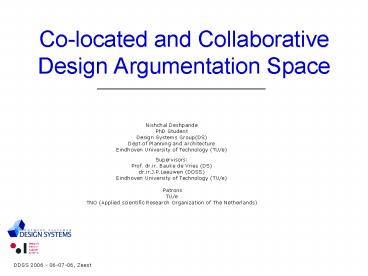Colocated and Collaborative Design Argumentation Space PowerPoint PPT Presentation
1 / 22
Title: Colocated and Collaborative Design Argumentation Space
1
Co-located and Collaborative Design Argumentation
Space
Nishchal DeshpandePhD StudentDesign Systems
Group(DS)Dept.of Planning and ArchitectureEindho
ven University of Technology (TU/e)
Supervisors Prof. dr.ir. Bauke de Vries
(DS) dr.ir.J.P.Leeuwen (DDSS)Eindhoven
University of Technology (TU/e)
PatronsTU/e TNO (Applied scientific Research
Organization of The Netherlands)
DDSS 2006 - 06-07-06, Zeest
2
Introduction
- Area of Research
- Design Teams, Architectural design Domain
- Challenge
- Dynamic nature
- - Multi-disciplinary
- - Collaborative
- - Synchronous
3
Objectives
- Developing Shared Understanding
- Capturing the design process
- Effective way to represent, structure and access
dynamic elements of a collaborative session - design Unobtrusive interface and interaction
techniques
4
Hypothesis
- Argumentation is the main way of discussing
points between members of a design team - Shared Understanding equals the construction of
Design Rationale - Argumentation as design rationale
5
Contribution of the Research
- Developing a Hybrid notation scheme to capture
and visualize dynamic elements - Developing a representation and structuring
method to capture, link and show the knowledge,
documents and their with arguments to team
members - An attempt in Conceptualizing a GUI collaborative
interface to achieve objectives
6
Capturing arguments
- Communication and reasoning
- Keeping track of issues and eventual arguments
and Process - Facilitates in understanding what others have
done - Deliberation process and arguments with
appropriate labels
7
Roots of Argumentation
A seminal paper A vision A conceptual
framework for augmentation of mans
intellect (concept structure -
Englebart) Representational form TBL (Toulmin
Based Logic -Toulmin) QOC (Question, Option,
Criterion (MacLean) IBIS (Issue Based
Information Systems (Rittel)
8
drawbacks
- Not intended for multi-disciplinary collaborative
activity - No representation of dependent relations between
members views - No link between argumentative and design artifact
construction activities - Overall representation of the session is not
possible, focus on single issues - Organization of rationale elements according to
the task at hand not supported (following the
process)
9
Our approach
- Recognizing rationale as a collection of three
elements - Knowledge, arguments and design documents
- Construction of collaborative knowledge and
creation of concept structures - Creation of argument structures and decisions
- Design document support
- Bridging the above three
10
(contd.)
- Causal Mapping of concepts (Knowledge, concept
structuring) - Statements -gt Concepts -gt values --? Causal
Mapping - Statements are systematically challenged
in order to expose them to viewpoints of the
other sides and the structure of the process
becomes a following process - (Rittel)
- Advantages
- Many collaborative situations are best
understood in cause to effect relation - Advantage of upgrading to decision Networks
- Adapted Ibis structure (argument construction)
- Advantages
- Generic and seems promising
11
Framework
Each Element is an Object that holds Information
about Self i Information about Relations
CDAS Framework
12
The space
Visualization and communication spaces
Architecture
Interaction spaces
13
Interaction SpaceMembers Space
Interface sketch of Interaction Space
14
- Knowledge Space
- Knowledge construction
A Group of Statements
A concept
A concept
A concept
A Value
15
Contd.
Knowledge and concept structure
16
Contd.
Knowledge Evaluation
Generating and incorporating cases
Screen shot of the Network - Netica(Norsys
sofware)
17
Argument SpaceArgument construction
Argument Structure
18
- Argument Structure
Sketch of Argument Space
19
Design Document Space
Browse and organize Session documents Evidence/Su
pport Annotation/edit
20
Initial test
2 Sittings Traditional Brainstorming
Proposed causal mapping gt Wizard-of-oz
Relatedness rating of Concepts (Langan-Fox)
Result of initial test (knowledge construction)
21
- Conclusions
- Work in progress
- New Hybrid structuring approach to combine all
rationale elements - Three spaces defined
- To fully take advantage of DNs,find ways to
minimize the existing gap - between informal knowledge construction methods
and formal DN - construction
- Positive feeling on conceptual schema
Skeptical on collaborative interface and
interaction
- Future Work
- Continuation of prototype implementation
- Focus on controlled experiment design
- Analysis of Arguments
- Further study on new interaction
techniques/tools
22
Thank you.

